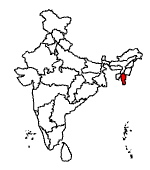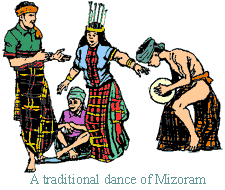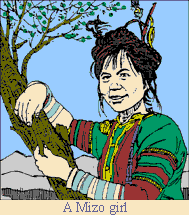
Dimdima
Online Children's Magazine from India

Dimdima
Online Children's Magazine from India
Mizoram was part of the state of Assam when India became independent. It became a Union Territory in 1972 and the 23rd state of the Indian Union in 1987.
Area: 21,087 sq km
Population : 8,91,058
Language : Mizos have accepted English as their medium of instruction, but the Mizo language is still widely spoken.
Capital : Aizawl.
Literacy rate : 88.06%.
Location :
Mizoram nestles in the northeastern corner of India and is shaped like a narrow, inverted triangle.
The state borders Myanmar and Bangladesh in the south and east, while its domestic borders are shared with the states of Assam, Manipur and Tripura.
People :
The Mizos are divided into several tribes – the Lushais, Pawis, Paithes, Raltes, Pang, Himars, Kukis, Lakhers and others. They are originally believed to have come from northwestern China and moved towards their present homeland, about 300 years ago. They were earlier worshippers of the spirit called Pathan, but today the Mizo community is greatly influenced by Christianity. Mizos zealously preserve their old customs and lifestyle. This preservation has been possible due to the Inner Line Permit introduced by the British in the last century, which prevented outsiders from settling down in Mizoram, and posing a threat to the indigenous lifestyle.
Main Occupation :
Agriculture is the main occupation of the people. The ginger grown in this area is famous. Paddy, maize, mustard, sugarcane, sesame and potatoes are the other crops grown.
Industry : The major industries in the state are that of handloom and handicrafts. Sericulture is practised widely.
However, concerted efforts are being made to accelerate the growth of industries in Mizoram and some priority industries have been identified. These include agro and forest-based industries, handloom and handicrafts, electronics and consumer industries.
Climate :
The climate is generally cool and pleasant the year round but during the months of April and May, there are heavy storms that blow in from the northwest. Rainfall occurs between the months of May to September.
The inhabitants of Mizoram are called Mizos which means 'people of the hills'.
According to a Mizo tale the Mizos came out from under a rock at the beginning of time. When a number of them had come out, two Mizos started chattering away and they made such a noise that god thought too many people had come out and closed the opening.
Mizos do not all belong to the same tribe. There are a number of tribes but the main ones are the Lushai, Pawi and Lakher.
Most of the Mizo tribes originally lived in the hills of Burma. The Lushai started moving westwards into India some centuries ago and soon become the dominant tribe in the region that came to be known as the Lushai Hills.
The Lushai came into conflict with the British early in the 19th century when they began raiding areas under British control.
In the 1890's the British sent two expeditions into the Lushai Hills. Posts were set up at various places and a fort called Aijal (which later became Aizawl) was established. In 1895 the territory was annexed to British India.
In 1919 the British declared this area backward and encouraged missionary activity among the tribes. The Lushai and some other tribes converted to Christianity.
The Mizo Hills area was a part of Assam at the time of independence, in 1947. In 1972 it was granted the status of a Union Territory and renamed Mizoram. Mizoram became the 23rd state of the Indian Union in February 1987.
Mizoram is a land of hills.
The hills run from the north to the south towards Myanmar and are resplendent with green vegetation throughout the year. Phawngpui is the highest peak in these mountains reaching 2065 metres. The name actually means a vast meadow, but it is popularly known as the Blue Mountain. Rare species of rhododendron are found on its slopes.
The state capital Aizawl is built on a high ridge and does not see the sun for most of the day, making it an idyllic hill station. The influence of the British is seen in buildings like the Assam Rifles Centre and the Raj Bhavan. The Mizoram State Museum has an interesting collection of Mizo costumes, implements and stuffed animals.
Bazaars in Aizawl and other towns sell locally made artefacts and the Khumbeu, the ceremonial bamboo hat made of wild Hnahthial leaves, popular with tourists.
The Mizos though influenced by western culture have preserved their traditions. The most enduring of these is the Cheraw, or the "bamboo dance". Other dance forms are the Khuallam, a dance for visitors and the Chheih Lam, performed at the end of a day's work. Another surviving tradition is the weaving of the puan, the local costume characterized by its white, black and red stripes. It is worn on special occasions such as weddings and festivals.
Traditional Mizo festivals are all associated with agricultural activities and are celebrated with great gusto.
The two traditional games of the Mizos are the Inbuan, a form of wrestling and the Insuknawr, where two men armed with long bamboo rods strive to push each other out of a circle.
British missionaries introduced the Roman script for the Mizo language and taught the people English. Today English is widely spoken in Mizoram and the literacy rate there is the second-highest in India.



Dimdima is the Sanskrit word for ‘drumbeat’. In olden days, victory in battle was heralded by the beat of drums or any important news to be conveyed to the people used to be accompanied with drumbeats.
Bharatiya Vidya Bhavan
K. M Munshi Marg,
Chowpatty, Mumbai - 400 007
email : editor@dimdima.com
Bharatiya Vidya Bhavan
505, Sane Guruji Marg,
Tardeo, Mumbai - 400 034
email : promo@dimdima.com
Dimdima.com, the Children's Website of Bharatiya Vidya Bhavan launched in 2000 and came out with a Printed version of Dimdima Magazine in 2004. At present the Printed Version have more than 35,000 subscribers from India and Abroad.